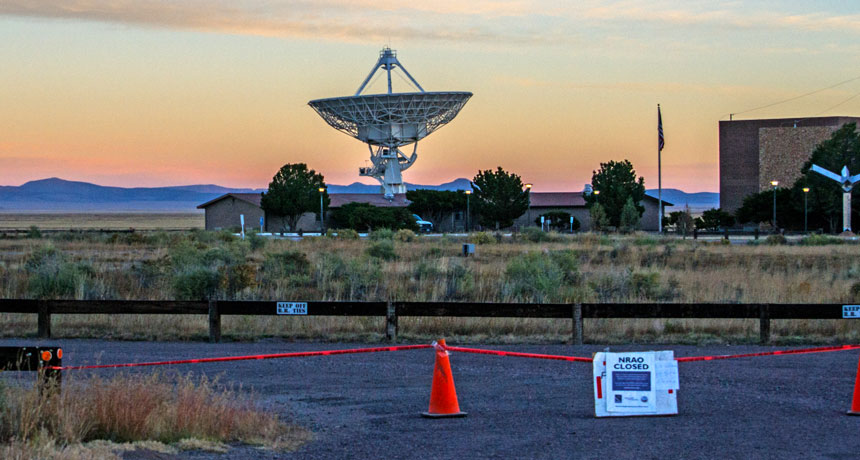Here’s how the record-breaking government shutdown is disrupting science
The shutdown is forcing scientists to cancel presentations and halt research

TEMPORARY WORKAROUND For now, the National Radio Astronomy Observatory based in Charlottesville, Va., shown here closed during a 2013 government shutdown, is still open, funded by money left over from 2018. But if the current shutdown doesn’t end soon, it may be forced to close again.
Emily Barney/Flickr (CC BY-NC 2.0)
- More than 2 years ago
As the partial federal government shutdown enters its fourth week — on January 12 becoming the longest in U.S. history — scientists are increasingly feeling the impact. Thousands of federal workers who handle food safety and public health are furloughed. Countless projects researching everything from climate change to pest control to hurricane prediction are on hold.
Among government agencies hit by the partial shutdown are the U.S. Geological Survey, the Department of Agriculture, the National Oceanic and Atmospheric Administration, the Environmental Protection Agency and NASA, where nearly all employees are on leave. Additionally, 40 percent of the Food and Drug Administration’s 14,000 workers are furloughed, as are most employees of the National Parks Service and the Fish and Wildlife Service.
Meanwhile, the National Science Foundation, responsible for doling out nearly $8 billion in research funds each year, has stopped awarding grants and has canceled review panels with outside scientists that are part of the process. In 2018, NSF gave out $42 million in grants from January 1 through January 8, but this year, nothing has been funded so far, Benjamin Corb of the American Society for Biochemistry and Molecular Biology noted in a statement January 8. Such stalled funding is leading to a backlog that could slow down approvals long beyond the shutdown. Here are some of the consequences of delaying government research, and how some scientists are trying to cope.
Public safety
Both the National Institutes of Health and the Centers for Disease Control and Prevention remain funded and operational. Flu surveillance is still being funded through the CDC. Medicare and Medicaid insurance programs are also safe.
But other agencies working to protect public health have scaled back operations. The Indian Health Service, which funds care for Native Americans, is in limbo. Health clinic employees are working without pay, while some grants and programs are on hold.
The USDA is still inspecting meat, dairy and poultry products. But routine FDA inspections of produce are suspended, increasing the possibility of a foodborne illness outbreak. Given that worry, the agency hopes to resume inspections of high-risk facilities prone to outbreaks, FDA commissioner Scott Gottlieb told the Washington Post.

Weather forecasts have become less accurate, with the National Weather Service’s key prediction tool not working correctly and no one around to fix it, the Washington Post also reported, citing Suru Saha of the National Weather Service’s Environmental Modeling Center in College Park, Md.
Meanwhile, work to improve hurricane models by adding the latest in physics and data isn’t happening, forecaster Eric Blake at the National Weather Service’s National Hurricane Center in Miami told Scientific American.
Environment damage
EPA employees policing industry compliance with laws restricting air and water pollution are on leave, and work to clean up Superfund sites, areas of extreme environmental contamination, is suspended. That means any research into the potential health or environmental effects of new contaminants is on hold.

National parks are also in disarray, with few rangers to control crowds or enforce sanitation rules or regulations against environmental damage. Visitors wanting to drive off-road through the California desert cut down protected Joshua trees to clear a path in Joshua Tree National Park, park superintendent David Smith told National Parks Traveler. It can take years for desert soils and slow-growing Joshua trees to recover from such damage.

Information access
Scientists aren’t able to gather data from government websites that are not being updated or are now offline. That’s hurt climate scientist Angeline Pendergrass’ work building computer models at the National Center for Atmospheric Research in Boulder, Colorado, to predict how climate change will impact rainfall patterns.
Pendergrass normally verifies her calculations against precipitation records housed in the Global Historical Climatology Network, which logs global temperature and rainfall measurements. But while those data are still being collected automatically, the data aren’t available as usual through NOAA. Pendergrass’ project was stalled for days until she found a workaround to access the data in a different way.
“I worry a lot about missing observations” from monitoring equipment malfunctions, Pendergrass says, which could mess up her research.
Her concerns are well-founded. About 10 percent of contributing U.S. weather stations appear to be offline, lead scientist Robert Rohde at Berkeley Earth, an independent group for scientific analysis based in Berkeley, Calif., tweeted. And data from “a large number of foreign stations are also not being merged into the archive,” he wrote.
Animals in USDA facilities are still being cared for, but scientists can’t collect data or do experiments. Interruptions in animal research involving steps being taken at certain times — like cows that need to be bred at a certain age — can set researchers back months or even years.
Scientific collaboration
During the shutdown, federal scientists can’t attend scientific meetings — important arenas for sharing new research. Already, government scientists have missed key conferences on astronomy, biology, weather and agricultural science.
More than 10 percent of planned participants at the American Astronomical Society meeting that just wrapped up on January 10 in Seattle had to cancel presentations, AAS spokesman Rick Fienberg says. Some were able to ask coauthors to take their place; astrophysicist Jane Rigby at NASA’s Goddard Space Flight Center was not one of them.
Rigby had to abandon her planned talks about the James Webb Space Telescope because nobody outside of the U.S. space agency had the expertise to cover for her. “This is the Super Bowl of astronomy, and we’re not allowed to play,” she says. “It’s not even like we’re benched. We’re not even allowed in the stadium.”
Hundreds of USDA employees have also pulled out of the San Diego meeting of the International Plant & Animal Genome that starts January 12, says conference co-organizer Alison Van Eenennaam, an agricultural genomicist at the University of California, Davis.
Because future research priorities are decided at such conferences, she says, the cancelations “will have implications for the whole year’s research.”
One of Van Eenennaam’s graduate students relies on a USDA computer server to run a simulation program for research that’s needed to complete her degree. She isn’t allowed to access it right now, so the planned updates to make the program more suitable to the project’s needs also aren’t happening.
“She’s stuck,” Van Eenennaam says.
Timely research
Some scientists can ride out any funding delays. But for those working on projects that are time sensitive, the halt in funding approvals threatens to throw off an entire year of work.
Physiologist Hannah Carey is still waiting for this year’s money to come in for her research at the University of Wisconsin–Madison on ground squirrel hibernation. Because hibernating animals endure extreme changes in body temperature and heart rate, studying how they cope could help scientists understand how human bodies deal with trauma or extreme conditions.

“We’re OK for the time being,” she says, but the stopgap money from the university “isn’t an infinite well” and she doesn’t know how long it will last. Delaying the project is not an option, though; the research requires monitoring brief periods of arousal during squirrels’ natural hibernation cycles, and winter is when the squirrels in her lab are asleep. Regardless of the government, “the squirrels carry on.”
Editor’s Note: Astronomy writer Lisa Grossman contributed to this story.







